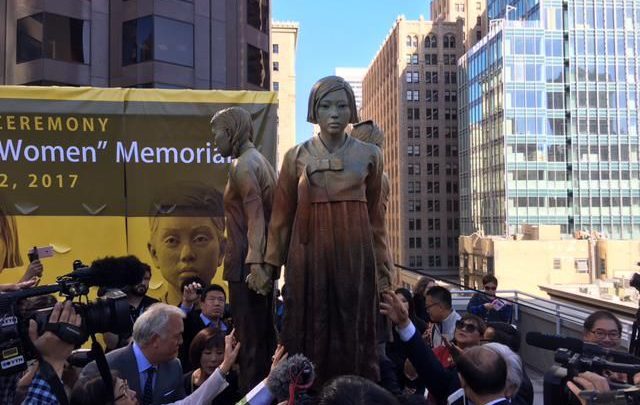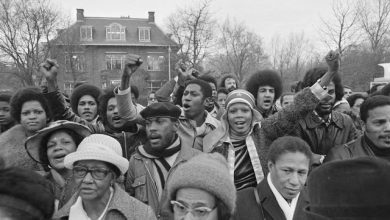AllOngoingThe Americas
San Francisco, Osaka and Korean Comfort Women
After the erection of a statue depicting Korean Comfort Women was erected in San Francisco last year, its sister city Osaka threatened to cut ties over what was seen as a disrespectful move towards reconciliation with South Korea. What are the updates a whole year later?

During the height of the Imperial Japanese Occupation of Asia, a brothel-like system was put in to place across the occupied territories to prevent mass wartime rapes. After the fall of the empire, the women were free to return to their home countries. Unfortunately, they often faced decades of painful stigmatization from their own people.
Many grew old, never married and never had children. Korean comfort women began to speak out against their treatment under Imperial Japan in the late 1990’s, and since, many rights groups have attempted to wedge any kind of reconciliation between ROK and Japan, despite various bilateral agreements and treaties between the two. A statue erected in San Francisco, CA last year has been one of the latest moves that tempered the healing wound between Japan and South Korea.
Agreements and Treaties
Forty-eight nations signed a treaty of peace with Japan in 1951. Named the “San Francisco Peace Treaty,” this agreement was the document which officially ended World War II. In addition, the signing of the treaty reestablished Japanese sovereignty.
Under the document:
- Allied powers recognized the full sovereignty of Japan;
- Japan renounced all claims on various countries including Korea, Taiwan and Hong Kong;
- All occupation forces were withdrawn from Japan;
- Japan agreed to enter repayment on reparations for damage and suffering caused during the war;
- Japan agreed to accept judgments of the International Military Tribunal
Women’s Rights
In the 1990’s, groups advocating for women’s rights began to fight for the rights of the women who served in these systems during the war. In cooperation with the Japanese government, the Asian Women’s Fund was established in 1994 in order to provide monetary compensation in an act of good faith to the women from the Japanese government. Over 1 billion yen was donated to the cause.
Although the relationship between Japan and South Korea was strained, a 2015 bilateral agreement between the two helped move past issues forward significantly. Alas, a nonprofit organization based in California insisted on erecting a comfort women statue in San Francisco, which obviously prompted ill feelings between the city and the country of Japan.
Sister Cities and Korean Comfort Women
Osaka Japan and San Francisco CA have been designated sister cities. Both helped build bridges of friendship and commerce between two world points of culture and finance. The erection of the statue, and refusal of the Mayor of San Francisco to condemn it highly offended the Japanese people both in the city and in Japan.
Many criticize the erection of the statue as an impediment to the goodwill between cities and yes, even countries. Because the organization that planned and funded the statue is a representative of the Korean population in the Bay area, Japanese citizens took the initiative as a “siding” with the Korean diaspora, regardless of ties both had forged over many years.
The Mayor of Osaka was highly offended by the actions of his sister city, that he threatened to cut the symbolic sister city designation. This was a win for the Korean organizations, whose long-held response to the sister city initiatives was the understanding that California and the Japanese ethnic population there held a stronghold over San Francisco.
Analysis, a Whole Year Later
The ethnic Korean population has the right to express their grievances towards the country of Japan. This, however, is best done through the proper channels. Funding set up to build and maintain the monument would be better served donated to funds supporting the remaining Korean comfort women. The erection of statues such as these are detrimental to international relations, and non-profit organizations have no business trying to interrupt the path forward.
The path forward being mentioned, both countries have moved several times to try and alleviate the historic grievances against former occupied countries such as Korea and Taiwan. Many decades of delicate bilateral relations, including high-level talks, funding, loans and apologies cease to be effective when civilian citizens in various countries insist on using this issue as political fodder for their own divisive agendas. How many times does Japan have to apologize? And for many generations will the Japanese people continue to be blamed for the grievances of their ancestors?
Hopefully, this issue will blow over. In addition to San Francisco, statues erected in Busan South Korea and Taiwan have also cause hostility between countries. San Francisco, however, had no part in this particular WWII incident. As such, they should not be dragged in to the international spat between the two (currently flourishing) Asian nations.
With all of this being said, the sister city designation between Osaka and San Francisco was once a beautiful thing. From high school student delegations and exchanges of culture, technology and mutual respect, this move shows the sensitivity of issues that should be left in the past, and the willingness (for some, at least) to move forward from the legacy of former Korean Comfort Women.




